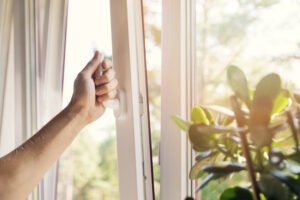Both make-up air and fresh air are important for indoor air quality, but they serve slightly different purposes.
Fresh air:
It is simply unconditioned air that comes from the outdoors and It can be brought into a building through open windows, doors, or ventilation systems. It is important for diluting indoor air pollutants and providing oxygen.

Composition:
- Fresh air is primarily composed of nitrogen (around 78%) and oxygen (around 21%).
- It also contains smaller amounts of other gases like argon, carbon dioxide, and trace elements.
Desirable Qualities:
- Low levels of pollutants: This includes harmful gases like carbon monoxide, sulfur dioxide, and nitrogen oxides. It also means minimal airborne particles like dust, smoke, and allergens.
- Moderate temperature and humidity: Fresh air is typically neither too hot nor too cold, and it has a comfortable level of moisture content. This can vary depending on climate and personal preference.
- High oxygen content: Fresh air has a relatively high concentration of oxygen (around 21%), which is essential for human health and well-being.
Benefits of Fresh Air:
- Improved cognitive function: Studies suggest fresh air can enhance alertness, memory, and concentration.
- Reduced stress and anxiety: Spending time outdoors in fresh air has a calming effect and can help lower stress levels.
- Boosted immune system: Fresh air may help to strengthen the immune system by increasing white blood cell production.
- Improved sleep quality: Breathing fresh air before bed can promote deeper, more restful sleep.
- Overall sense of well-being: Spending time outdoors and breathing fresh air can leave you feeling energized, refreshed, and more connected to nature.
Sources of Fresh Air:
- Natural environments: Mountains, forests, beaches, and rural areas tend to have the freshest air due to minimal human activity and abundant natural filtration.
- Open spaces: Parks, gardens, and even your own backyard can provide access to fresh air, especially if located away from busy roads or industrial areas.
- Ventilation: Proper ventilation in homes and buildings is crucial for bringing in fresh air and removing stale air. Opening windows and using ventilation systems are ways to achieve this.
Things to Consider:
- Air quality can vary: Pollution levels can fluctuate depending on location, weather conditions, and human activities. Air quality monitoring reports can help you understand the air quality in your area.
- Seasonal variations: Fresh air composition and quality can change throughout the year. For example, pollen levels might be higher in spring.
Make-up air:
It is specifically introduced to replace air that has been exhausted from a building. This can happen due to exhaust fans in kitchens, bathrooms, or industrial facilities. Make-up air units typically condition (heat or cool) and filter the incoming outdoor air before introducing it into the building. This helps to maintain a comfortable indoor temperature and prevent drafts.
Why is Make-up Air Needed?
Several reasons necessitate the use of make-up air systems:
-
Maintaining Pressure Balance: When exhaust fans, range hoods, clothes dryers, or other ventilation systems remove air from a building, they create a negative pressure situation. This means the air pressure inside the building is lower than the outside pressure. Without make-up air, outside air will be sucked in uncontrollably through leaks, cracks, or openings. This can be inefficient (pulling in hot or cold air), uncomfortable (creating drafts), and even hazardous (drawing in pollutants).
-
Ensuring Proper Ventilation: Exhaust systems remove stale air, contaminants, and pollutants from a building. To maintain good indoor air quality (IAQ), this removed air needs to be replaced with fresh outdoor air. Make-up air systems fulfill this role.
-
Preventing Backdrafting: Negative pressure can cause backdrafting in combustion appliances like furnaces or water heaters. This can lead to incomplete combustion, releasing harmful gasses like carbon monoxide into the living space. Make-up air helps prevent this by maintaining a balanced pressure.
How Does Make-up Air Work?
Make-up air systems typically consist of the following components:
- Intake: An opening that allows fresh outdoor air to enter the system.
- Filtration: Filters remove dust, pollen, and other contaminants from the incoming air. This ensures the introduced air improves, not worsens, indoor air quality.
- Conditioning (Optional): In some cases, the make-up air unit might heat or cool the incoming air to a more comfortable temperature before distributing it throughout the building. This can improve efficiency by reducing the strain on the main HVAC system.
- Distribution: Ductwork carries the conditioned (or unconditioned) make-up air to designated areas within the building.
Types of Make-up Air Units:
Make-up air units come in various configurations depending on the building size and specific needs. Here are some common types:
- Direct Fired Makeup Air Units: These units use a burner to directly heat the incoming air. They are efficient for heating but may not be suitable for all applications.
- Indirect Fired Makeup Air Units: These units use a heat exchanger to transfer heat from a boiler or furnace to the incoming air. This allows for more precise temperature control.
- Evaporative Cooling Makeup Air Units: These units use the process of evaporation to cool the incoming air. They are energy-efficient in hot, dry climates.
- Unconditioned Makeup Air Units: These basic units simply filter and introduce outside air without any temperature control.
Benefits of Make-up Air Systems:
- Improved Indoor Air Quality: Fresh air replaces stale air and reduces indoor air pollutants, leading to a healthier environment.
- Enhanced Comfort: Proper ventilation prevents drafts, eliminates stuffiness, and maintains comfortable temperature and humidity levels.
- Increased Efficiency: Balanced pressure reduces strain on exhaust systems and can improve the overall efficiency of the HVAC system.
- Reduced Health Risks: Make-up air helps prevent backdrafting and ensures proper ventilation for combustion appliances, minimizing health risks from carbon monoxide exposure.
Things to Consider with Make-up Air:
- Climate Control: Depending on the climate, conditioning the make-up air might be necessary for maintaining comfort and efficiency.
- Energy Efficiency: Choose a make-up air unit that is the right size for your building and consider energy-efficient options like indirect fired or evaporative cooling units.
- Maintenance: Regular maintenance of filters and other components is crucial for optimal performance of the make-up air system.
Here’s a table summarizing:
In essence, Pure air is any new air brought in from outdoors, while make-up air is specifically used to compensate for exhausted air.
Looking to install a commercial HVAC System or Duct work in your Business Area?
Contact Vipul Ac to learn about our HVAC Service
Call +91 9825636606 Today.



